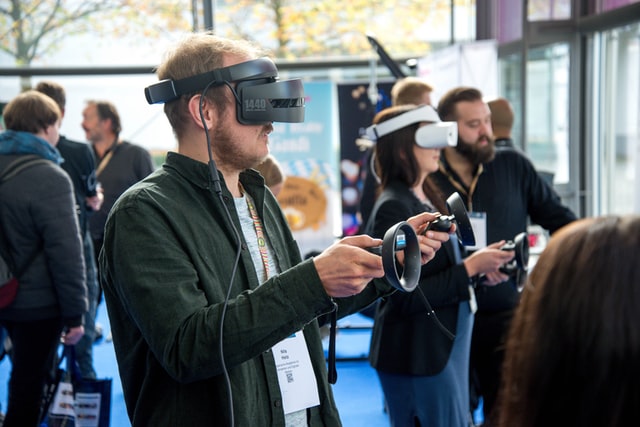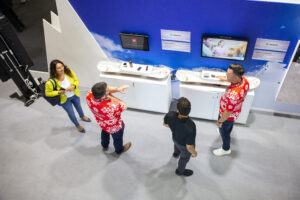
While the pandemic wrought absolute chaos on the events industry – it left us in better shape too.
Wait – before you start throwing things.
Covid sped up the adoption of digital technology up by several years. Anecdotally we know this, but it is backed by tons of research, including that from McKinsey & Company. And with predictions that 35.5% of US internet users will be using augmented reality (AR) by 2025, jawdropping, immersive experiences are no longer just the reserve of huge global brands.
At the moment, as AR guru The Ghost Howls says, each area of AR – namely, smartphone AR, passthrough AR on VR headsets, and AR glasses – are all at different stages of adoption. But at some point – all three will converge and that, my friends, is when AR will go mainstream. Probably.
A raft of studies shows the benefit using AR can have on brands – engaging customers far more effectively and making the intangible tangible.
For brands who’ve not yet dabbled in immersive tech – here are some great ways you can introduce it in your next exhibition design.
AR overlays
Picture this – you’re a manufacturer of components used in electric cars. A simple, undeniable fact of psychology is that we like to keep things simple. Humans are not built for complexity, we’re not wired to read thick, dull as ditch water product brochures on a s

tand – nor do we like to be sold to using stats and figures.
Compounding this, flat graphics detailing use-case scenarios or even benefits of the product is tough when the product is not necessarily a tangible object. And maybe that product is a niche little component, which sitting on its own on a plinth, really doesn’t tell you much.
But if you were to overlay those graphics with AR – by say – encouraging users to scan a QR code on their smartphones to lead them to how this product works in situ – you could tell a much more exciting – and memorable – story. And people are ready. 56% of shoppers surveyed by NielsenIQ said that AR gives them more confidence about the quality of a product, and 61% said they prefer to shop with retailers that offer AR experiences.
If you’re looking for a recent example of what can be achieved without the need for a headset, take a look at the work Vodaphone, OPP and Amex did around Wimbledon this year. Vodaphone’s immersive Walk of Champions, where Tim Henman walks you to Centre Court through the Clubhouse, sharing some of his favourite memories of competing, is a fantastic experience.
Object recognition in exhibition design
Large or diverse portfolio? You could look at combining object recognition and AR in your exhibition design. Pre-programmed custom objects representing each product can be placed on a surface table, against a backdrop of digital screens within the exhibition space. This triggers ‘hotspots’ around the object which can be selected to run on-screen video or product information. When this object is viewed through an iPad, the object will appear as an augmented 3D object. Some of the most exciting examples of this are still in art, gamifying visitor experiences with scavenger hunts to encourage families to engage in exhibits.
Meeting room manager
OK so this isn’t exactly immersive – but if you’re not doing this by now, you’re missing a trick. Free up your team’s headspace and time with meeting scheduling software. Better organisation reduces the downtime of your meeting rooms and meeting spaces. This has a huge impact on your return on investment from your space as meeting rooms usually take up a sizable footprint. A meeting planner, usually managed with an iPad, can be combined with screens on stand that highlight meeting space availability or the whole schedule. By showing this kind of information, your team will be able to seamlessly work alongside each other, making the best use of your space. You should aim for total brand continuity by using apps with customisable interfaces.
Beacons
 Much like using a meeting room manager, deploying beacon tech feels like a rather obvious thing to do – but it is still not a standard consideration for the majority of brands. And it should be. It needn’t be expensive, you can pick a solution in the hundreds rather than the thousands – and there are tons of benefits. Attendees will be able to find you and any activities you plan on stand easily – especially helpful when navigating cavernous exhibition halls. Once your visitor is in range of a beacon they’ll receive a notification on their phones or wearable device. It might be a warm welcome at the entrance to the exhibition hall, or it might be a prompt to download more info about a nearby product.
Much like using a meeting room manager, deploying beacon tech feels like a rather obvious thing to do – but it is still not a standard consideration for the majority of brands. And it should be. It needn’t be expensive, you can pick a solution in the hundreds rather than the thousands – and there are tons of benefits. Attendees will be able to find you and any activities you plan on stand easily – especially helpful when navigating cavernous exhibition halls. Once your visitor is in range of a beacon they’ll receive a notification on their phones or wearable device. It might be a warm welcome at the entrance to the exhibition hall, or it might be a prompt to download more info about a nearby product.
And if that wasn’t enough to convince you – beacons have also proven successful in reducing brochures and sales information at exhibition shows, which in turn slashes printing and shipping costs. Most beacon tech is compatible with apps attendees already have on their phones, so set up and take up is seamless.
Data capture
Beacon technology, built on the transferring of data via Bluetooth, is a great way to generate useful insights about attendees. From how long they spend at your stand, right through to what products they engaged with. This kind of intel is gold dust for your marketing, sales and customer services people. Aside from beacon-generated data, a very simple application that saves teams time and money is the ability to scan business cards in multiple languages, using OCR technology. This makes any follow up quicker with fast and easy lead entry. This means you’re following up while your sales conversations are likely to still be fresh in your prospects’ minds. By moving away from clipboards, and online you’re paving the way for marketing automation, CRM integration and complying easily with data protection legislation.
Last but not least – if you’re asking attendees to fill in data on stand, with an iPad for example, make sure you keep the experience consistent with branded, bespoke forms. Every single tech integration you bring to your experience needs to look and feel like your brand.
When it comes to using tech to engage your customers, there is no one size fits all. You need a coherent strategy with clear objectives. We can help you! Let’s have a chat.
Want more info? Here are some more great ideas about how you can engage your audience with AR.